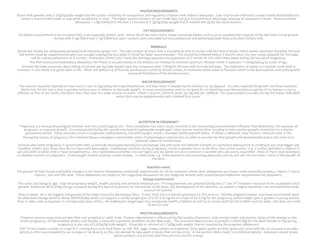Nutrition Guidelines for Weaning Infants
When introducing solid foods to infants starting at six months, it is important to remember that breastmilk remains a vital part of their diet. Weaning helps in the development of the infant's intestinal tract and the ability to digest proteins, fats, and carbohydrates. However, weaning too early or too late can have negative effects on both the infant and the mother. It is crucial to follow a gradual process to ensure the infant receives adequate nutrition and develops healthy eating habits.
Download Presentation

Please find below an Image/Link to download the presentation.
The content on the website is provided AS IS for your information and personal use only. It may not be sold, licensed, or shared on other websites without obtaining consent from the author. Download presentation by click this link. If you encounter any issues during the download, it is possible that the publisher has removed the file from their server.
E N D
Presentation Transcript
NUTRITION DURING INFANCY WEANING
>giving of foods to infants starting at six months, in addition to breastmilk. >NOT sufficient as on their own as a diet >Should NOT displace breastmilk
IMPORTANCE OF STARTING WEANING 1. Infant s intestinaltracts develops immunologically with defense mechanisms to protect the infant from foreign proteins
2. The infants ability todigest and absorb proteins, fats, and carbohydrates, other than those in breastmilk increases rapidly.
3. The infants kidneysdevelop the ability to excrete the waste products from foods with a high renal solute load, such as meat.
4. neuromuscular mechanisms needed for recognizing and accepting a spoon, masticating, nonliquid foods, and appreciating variation in the taste and color of foods. The infant develops the swallowing
Reduce breast milk production or intake. Contribute to increased rates of infant mortality and morbidity. Increase the riskof mothers becoming pregnant. Interfere with iron absorption.
Reject foods when they are introduced at a later age. Consume an inadequate variety & amount of food to meet their nutritional needs.
GO GLOW GROW
FoodGroup Age of Introduction inMonths 6 7 8 9 10 11 12 Rice orcooked cereal, cup, strained cup, 1 cup soft cooked rice cup thick cereal cupthin cereal Pulse strained 2-3tbsp 1piece Dissolved in milk Breador biscuit
Food Group Age of Introduction inMonths 6 7 8 9 10 11 12 Fruits, ripe, like tomatoes oranges,s weet lime,grap es 2 tbsp mashed or in juice form 3 tbsp.cut intosmall pieces 4 tbsp.cut intofinger sized pieces Soups cup Vegetabl es, cooked 1 tbsp mashed 1 tbsp finely chopped 1-2 tbsp.coarsel ychpopped
Food Group Age of Introduction in Months 6 7 8 9 10 11 12 Meat, fish, andpoultry, cooked well, ground, flaked or minced, fish liver oil 1-1/3 Servings 1-1/3 srvgs 1-1/3 srvgs 1-1/3 srvgs 1-1/3 srvgs 1-1/3 srvgs 1-1/3 Srvgs tsp mixed in small quantity of milk Whole Milk 2 cups Cooking Oil or margarine, may be added to lugao or meat & vegetable dish 4 tsp Sugar 3 tsp 3 tsp 3tsp 1tsp 3 tsp 3 tsp 3 tsp 3 tsp Custards,pudding,
TIPS FOR INCREASING NURTRITIVE VALUE OF WEANING FOODS
Cook rice or other cereals thicker by preparing it with less water. Add mashed/finely chopped vegetable, meat, fish, eggs, & fruits Add fortified milk, sugar or chocolate powder Add a little cooking oil, margarine or butter to the feed.
General Guidelines To Follow When Preparing Infant Foods at Home
Before breastfeeding, formula feeding, or preparing any food or bottles; Before handling any food or food utensils; After handlingrawmeat, poultry, or fish; After changing an infant s diaper and clothing; After using the bathroom or assisting a child in the bathroom; After sneezing or coughing into tissues or hands or wiping noses, mouths, bottoms, sores, or cuts; and After handling pets or other animals or garbage.
Washing of Hands is a must... Before preparing food, wash all working surfaces used to prepare food such as counter tops or tables with soap and hot water, and then rinse thoroughly with hotwater.
Washing of Hands is a must... Before preparing food, wash all equipment, such as a blender,food processor, infant food grinder, utensils, pots, pans, boards carefully with soap and Rinse thoroughly with hot water and allow to air dry. Separate cutting boards used for animal foods (i.e., meat, poultry, fish) and non-animal foods (i.e., vegetables, fruits, breads). and cutting hot water. should be
Preparation Common kitchenequipment is all that is necessary to make infant foods at home. A simple metal steamer, available in most supermarkets, can be used to cook fruits and vegetables and will reduce the loss of vitaminsin cooking.
Serving and Storage Home-prepared infant foods should be used immediately and quickly stored in a properly functioning refrigerator or frozen for longer storage.
Blender or food processor purees foods, including meats, vegetables, and fruit, to a very consistency,if desired; smooth
Fine mesh strainer purees very soft cooked vegetables and ripe or cooked fruits the food would be pushed through the strainer with the back of a spoon;
Infant food grinder or food mill purees most foods to a smooth consistency and purees meats to a coarser consistency
A kitchen fork or knife mashed with a fork or chopped finely with a knife, for older infants.
TYPES OF SUPPLEMENTARY OR WEANING FOODS
LIQUID SUPPLEMENTS Milk-Cow s milk diluted with water in 2:1 ratio. Sugar can be added. 225 ml Juice of fresh fruits-Oranges, tomatoes, sweet lime, grapes juices. 85-170 ml Soups of GLV-Strained soups Fish liver oil-Few drops mixed in milk
SOLID SUPPLEMENTS MASHED Cereal and starchy gruels-Rice, rice flour,rice flakes, ragi flour mixed with milk and sugar, porridge, malted cereals Vegetables-Potato, GLV,carrots Fruits-Banana Non-veg foods-Hard boiled yolk(small portion), minced meat, boiled fish Pulses-Khichdi
SOLID SUPPLEMENTS UNMASHED Cooked cereals, pulses, veg, idli, bread, chapati, rice and dal. Chopped veg, cooked potato, leafy veg, raw carrot,
Ingredients: Whole wheat 80 g. Whole Soyabean 20 g. Method of preparation: 1. Clean whole wheat & soyabean separately. 2. Roast wheat and soyabean in hot sand. 3. Grind these separately and mix together. 4. Store the prepared instant food in an air tight container. Nutritive value per 100 gms: Calories 363 Protein 18 .1 g. Iron 6 .3mg. Carotene 136 g. Ingredients: Wheat flour (Whole) 100g. Bengal gram (Roasted & de-husked) 30 g. Groundnut (Roasted) 20g. Method of preparation : 1. Roast wheat flour. 2. Remove the skin of groundnut. 3. Make powder of roasted Bengal grams andgroundnut. Mix with Wheat flourthoroughly. 4.Store in a dry airtight container. Nutritive Value Per 100 gms : Calories 377 Protein 16 .1 g. Iron 5 .54mg. Carotene 41 .93 g
Ingredients : Raw Rice powder 150 g. Roasted Bengal gram Dal 50g. Method of preparation : 1. Wash & soak raw rice in water. 2. Remove water, dry under sun, grind it. Grind roasted Bengal gramdal. 3. Mix the twopowdered ingredients. 4.Store in a dry airtight container. Nutritive value per 100 gms : Calories 351 Protein 10 .3 g. Iron 1 .85mg. Carotene 32 .25 g. GRAM MIX Ingredients : Puffed Rice 100 g. Bengal Gram 30 g. (Roasted & de-husked) Method of preparation: 1. Prepare powder of puffed rice. 2. Grind roasted Bengal gram. 3. Mix all the powderedingredients thoroughly. 4.store in a dry airtight container. Nutritive value per 100 gms : Calories 335 Protein 10 .96 g. Iron 7 .26mg. Carotene 26 g.
Ingredients: Puffed rice 100 g. Roasted chana 30 g. Roasted groundnuts 20g. Sugar 50 g. Method of preparation: 1. Powder puffed rice after slightly roasting it. 2. Powder roasted chana and groundnut separately. 3. Mix all the ingredients and add powdered sugar. 4.Store in dry bottle. Nutritive value per 100 gms: Calories 374 Protein 9 .8 g. Iron 5 .1 mg. Carotene 17 g. Ingredients: Rice 30 g. Soyabean 20 g. Sugar 50 g. Method of preparation: 1. Roast rice and Soyabean separately. 2. Grind rice and Soyabean and mix together. 3. Add powered sugar and store in an air tightbottle. Nutritive value per 100 gms: Calories 390 Protein 11 g. Iron 2 .29 mg. Carotene 85 g.
Ingredients: Maize 100g. Lentil 30 g. Groundnut 20g. Sugar 50g. Method of preparation : 1.Clean and roast maize, lentil and groundnut seeds separately. 2. Grind individually to a fine powder. 3. Mix all these ingredients with powdered sugar. 4.Store in dry airtight container. Nutritive value per 100 gms : Calories 379 Protein 11 .93g. Iron 2 .59mg. Carotene 85 .5 g.
Points to be considered in introducing weaning foods Introduce only one food at a time. Allow the infant to become familiar with the food before trying to give another.Give very small amounts of any new food at the beginning, for example, one teaspoon full or less. At first strained fruits, vegetables and cereals are given. Fruit juice should be fed only by cup not by bottle. When the baby is able to chew, gradually substitute finely chopped fruits and vegetables usually at 8 to 9 months. Variety in choice of foods is important. Infants may object to taking some foods by themselves but will take them willingly if one is mixed with another, e.g., egg may be mixed with formula, cereal or vegetable. Vegetables may sometimes be made into soup with little milk until the baby becomes accustomed to the new flavour.
If, after several trials, the baby has an acute dislike for a particular food, omit that item for a week or two and then try again. If the dislike persists it is better to forget about the food for a while and substitute another. The mother or anyone feeding the infant must be careful to avoid showing in any way a dislike for a food which is being given. A baby's appetite varies a lot from meal to meal and day to day.When the child is teething or suffering from cold the child's appetite may be less. Use a very thin consistency when starting solid foods. Gradually the consistency is made more solid as the infant learns to propel the food back with the help of tongue. The child can be fed with a katori and spoon and the baby gets used to an adult method of feeding. To make the food calorie dense add oil, butter or ghee to the infant's diet. Food should be given between breast feeds.
Give freshly prepared food. Food should be only slightly seasoned. The addition of salt or sugar is not necessary in all foods. Water can be given in between feedings with a cup and spoon. Feeding an infant with supplementary foods demands greater skill and ingenuity on the of the part of the mother than the mere selection of suitable foods and cooking them in suitable ways. To guide the child to learn to eat and enjoy foods, the mother must be patient, resourceful not too serious. By one year, the infant can be given family diet, modified, in small quantities but at frequent intervals in addition to milk. The best indication of adequacy of the diet is the growth pattern of the child.
Low cost supplementary food Indian multipurpose food (C.F.T.R.I.)-Low fat groundnut flour and bengal gram flour (75:25 fortified with vitamins A and D, B1, B2, and calcium carbonate. Contains 42 per cent protein. Malt food (C.F.T.R.I.)-Cereal malt, low fat groundnut flour, roasted bengal flour (40:40:20) fortified with vitamins and calcium salts,Contains 28 per cent protein. Balahar (C.F.T.R.I.)-Whole wheat flour, groundnut flour and roasted bengal gram flour (70:20:10) fortified with calcium salts and vitamins.Contains 20 per cent protein. Supplementary food (NIN)-Roasted wheat flour, green gram flour or jaggery, (30:20:8:20).Contains 12.5 per cent proteins
Supplementary food (A.H.S.C.W) Kuzhandai Amudhu-Roastedmaize flour, green gram flour, roasted ground nut and jaggery (30:20:10:20) Contains 14.4 per cent proteins Win food (Gandhigram Rural Institute)-Pearl millet, green gram dal, groundnut flour, and jaggery. (50:15:25-25) Contains 20 per cent proteins. Amutham-Rice flour, ragi flour, bengal gram flour, sesame for groundnut flour and jaggery (15:15 15:10:10:25).Contains 14 per cent proteins. Poshak-Cereal (wheat, maize, rice or jowar) pulse (chana dal or green gram dal) and oil seed (ground nut) and jaggery.(4:2:1:2). Poshak (least cost weaning mix)-Same ingredients as poshak but in the proportion of 60:17:14:9
Kerala Indigenous Food (KIF)-Tapioca, Bulgar wheat (broken wheat or dalia) and groundnut (25:50:25) Low cost supplementary foods can be made at home by dry roasting with the above mentioned combinations or equal quantities of sprouted ragi, green gram, whole wheat, roasted channa, rice few almonds and making into powder.
Problems in weaning Obesity: Many infants are overfed by overzealous parents who mistake acceptance of food for appetite. Too early and too much quantity of feeding or too concentrated food can lead to overweight of the infant. Commercially available processed foods when overfed may lead to obesity.
Underweight: Too less quantity of food and less concentrated foods can lead to underweight. Bulky adult food when consumed by an infant gives satiety without meeting calorie requirement. This results in underweight of the child. Frequent illness and repeated diarrhoeas can also result in underweight of the child. Malnutrition in early childhood results in impaired cognitive and social development, poor school performance and reduced productivity in later life.
Food Allergy: Food sensitive enteropathis occur principally during first six months of life and mostly limited to early childhood. Predisposing factors may be malnutrition, infection and genetic background. Increased gut permeability, low level of secretory IgA and enzymatic immaturity put the infant at higher risk for allergy. The foods most frequently implicated in infant allergies are wheat, milk, egg and citrus juices. Rice is probably the most safe food of the commonly eaten cereals.
The consumption of wheat is best delayed until after the 6th month. Egg white, which is a potent sensitizer is usually deferred until the 10th month. Egg yolk is less allergenic and heat denaturation nonreactive. Pure orange juice does not give rise to allergic reactions in infants or children. Improperly prepared orange juice may contain excessive amounts of peel oil or of seed proteins which have leached into the juice from broken seeds and may therefore cause reactions in susceptible children. renders egg yolks
Allergy to milk is the most serious of the commonly encountered food allergy since milk supplies the requirements in early infancy. In most cases the allergy is due to the presence of lactoglobulins and lactoalbumin. The infant can be fed evaporated milk in which these proteins are denatured. Artificial flavours and been associated with respiratory allergic disorder. basic nutritional to some extent
Lactose intolerance: Lactase deficiency is usually not a problem for infants. So gain or failure to thrive in breast fed infants may be associated with excessive lactose intake. Mothers should lengthen the breast-feeding session on each breast or allow an entire to be taken at one breast. Refusal to take new food: If the child refuses to take new food, form of the food can be modified or should be mixed with the food he likes and should be tried again after a week or so.
Choking: Choking and aspiration can be caused as the child is trying to eat, run and breath at the same time Choking can be caused by peanuts, seeds, small hard sweets, crisps and raisins. Hard and big pieces of fruit like apple or vegetable or popcorn should be avoided for children under 3 years of age since they can cause choking which can lead to death.























